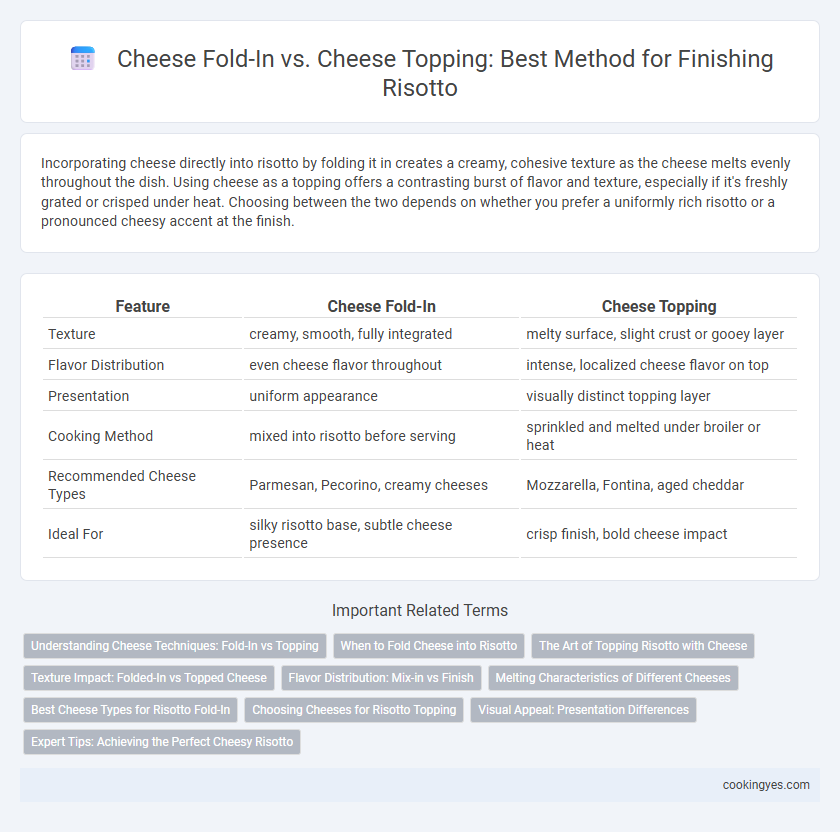Incorporating cheese directly into risotto by folding it in creates a creamy, cohesive texture as the cheese melts evenly throughout the dish. Using cheese as a topping offers a contrasting burst of flavor and texture, especially if it's freshly grated or crisped under heat. Choosing between the two depends on whether you prefer a uniformly rich risotto or a pronounced cheesy accent at the finish.
Table of Comparison
| Feature | Cheese Fold-In | Cheese Topping |
|---|---|---|
| Texture | creamy, smooth, fully integrated | melty surface, slight crust or gooey layer |
| Flavor Distribution | even cheese flavor throughout | intense, localized cheese flavor on top |
| Presentation | uniform appearance | visually distinct topping layer |
| Cooking Method | mixed into risotto before serving | sprinkled and melted under broiler or heat |
| Recommended Cheese Types | Parmesan, Pecorino, creamy cheeses | Mozzarella, Fontina, aged cheddar |
| Ideal For | silky risotto base, subtle cheese presence | crisp finish, bold cheese impact |
Understanding Cheese Techniques: Fold-In vs Topping
Folding cheese into risotto creates a creamy, cohesive texture as the cheese melts evenly throughout the dish, enhancing the flavor integration. In contrast, using cheese as a topping adds a distinct, concentrated burst of flavor and a slightly different texture that melts on the surface or offers a slight crust when broiled. Selecting between fold-in and topping techniques affects mouthfeel and intensity, making it essential to consider the desired richness and presentation in risotto preparation.
When to Fold Cheese into Risotto
Folding cheese into risotto is ideal when you want a creamy and fully integrated texture, allowing the cheese to melt evenly and enhance the dish's richness. This technique is best applied off heat to prevent the cheese from curdling and to maintain a smooth, velvety consistency. Using finely grated Parmigiano-Reggiano or Pecorino Romano during the final stirring phase ensures the cheese blends seamlessly, elevating the risotto's flavor and mouthfeel.
The Art of Topping Risotto with Cheese
Folding cheese into risotto creates a creamy, uniform texture that melds the flavors seamlessly, enhancing the dish's richness from within. Topping risotto with cheese as a final garnish adds a contrasting sharpness and visual appeal, allowing each bite to deliver bursts of intense flavor. Mastering the art of cheese application balances texture and taste, elevating the traditional Italian risotto experience.
Texture Impact: Folded-In vs Topped Cheese
Folding cheese into risotto creates a creamy, cohesive texture by integrating melted cheese throughout the dish, enhancing its smoothness and silkiness. Cheese topping, in contrast, adds a contrasting texture with slightly firmer, melted or browned patches that deliver bursts of concentrated flavor. The choice between fold-in and topping determines the final mouthfeel, influencing whether the dish feels uniformly rich or offers varied texture layers.
Flavor Distribution: Mix-in vs Finish
Folding cheese into risotto ensures even flavor distribution throughout each creamy bite, allowing the cheese to melt seamlessly and infuse the entire dish. Topping risotto with cheese creates a bold, concentrated burst of flavor on the surface that contrasts with the rice's texture. Mixing cheese in achieves uniform richness, while finishing with cheese offers distinct, flavorful highlights.
Melting Characteristics of Different Cheeses
Soft cheeses such as mascarpone and fontina fold seamlessly into risotto, creating a creamy texture due to their excellent melting properties. Harder cheeses like Parmesan or Pecorino Romano, typically used as toppings, provide a sharp, salty contrast and melt less uniformly, enhancing the dish's texture. Choosing the right cheese depends on the desired creaminess versus a pronounced cheesy finish, impacting the risotto's overall mouthfeel and flavor complexity.
Best Cheese Types for Risotto Fold-In
For the best cheese fold-in in risotto, Parmigiano-Reggiano, Pecorino Romano, and aged Asiago are top choices due to their sharpness and ability to melt smoothly into the creamy texture. Folding in cheese during the final stages of cooking enhances the risotto's richness and distributes flavor evenly compared to topping, which can create a less integrated taste experience. Soft cheeses like mascarpone or fontina also blend well, adding creaminess without overpowering the delicate arborio rice base.
Choosing Cheeses for Risotto Topping
Selecting the right cheese for risotto topping enhances texture and flavor by providing a sharp, creamy contrast to the creamy rice base. Parmesan and Pecorino Romano are ideal for their strong, salty notes that melt smoothly when sprinkled on hot risotto, creating a rich crust. Alternatively, softer cheeses like Gorgonzola or Fontina can be dolloped on top to introduce a tangy, luscious finish without overpowering the dish.
Visual Appeal: Presentation Differences
Folding cheese into risotto creates a creamy, uniformly textured dish with a glossy finish, enhancing the overall mouthfeel and subtle cheese infusion. Cheese topping, by contrast, offers a distinct visual contrast with melted or slightly browned patches that add texture and color variation on the surface. Risotto finished with a cheese topping often appears more rustic and inviting, while fold-in cheese delivers a smooth, polished presentation ideal for refined plating.
Expert Tips: Achieving the Perfect Cheesy Risotto
For a creamy, well-integrated flavor, fold cheese into the risotto off the heat, allowing it to melt evenly without curdling. Using Parmigiano-Reggiano or Grana Padano ensures rich umami and a smooth texture. Avoid topping with cheese alone as it can create a clumpy, uneven finish instead of the velvety consistency experts recommend.
Cheese fold-in vs Cheese topping for risotto finish Infographic

 cookingyes.com
cookingyes.com